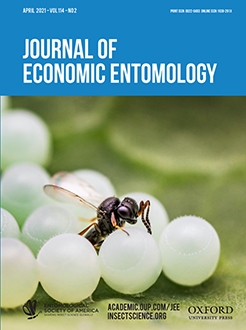To evaluate perimeter trap crops for management of harlequin bug, Murgantia histrionica (Hahn), we undertook greenhouse and field experiments with mustard greens as trap crop for a collard cash crop. We confirmed that harlequin bugs prefer to immigrate to and reside on mustard. Females, however, in greenhouse cage experiments, ‘commuted’ to collards to lay their eggs. In separate spring and fall field plantings, using replicated 12 m by 12 m collard plots in 1-ha fields, we tested mustard planted as an adjacent perimeter trap crop, or a perimeter trap crop separated by 2 unplanted rows (2.3 m), or with no trap crop. Adults accumulated on the spring mustard crop but overall numbers remained low, with all collards sustaining <1% leaves damaged. In the fall, the separation of 2.3 m reduced oviposition on collards fourfold, and feeding damage approximately 2.5-fold, compared to collards with an adjacent trap crop. Fall control plots with no border trap crop showed even lower foliar damage; likely result of preferential immigration of harlequin bugs to mustard at the field scale, resulting in fewer bugs near the control treatment plots. Thus, the spatial arrangement of the mustard trap crop, and its separation from the cash crop, influences pest abundance and damage. A separated mustard border can reduce bug movement including female commuting and egg-laying, thus better protecting the collard cash crop. Future research should address reduction in area of trap crops, deployment of semiochemicals, and possible changes in timing, to promote trap cropping that is practical for grower implementation.
How to translate text using browser tools
11 March 2021
Trap Cropping Harlequin Bug: Distance of Separation Influences Female Movement and Oviposition
Alexander D. Bier,
Anna K. Wallingford,
Ariela I. Haber,
Megan V. Herlihy-Adams,
Donald C. Weber
ACCESS THE FULL ARTICLE
It is not available for individual sale.
This article is only available to subscribers.
It is not available for individual sale.
It is not available for individual sale.

Journal of Economic Entomology
Vol. 114 • No. 2
April 2021
Vol. 114 • No. 2
April 2021
Brassicaceae
cole crops
commuting
crucifer
cultural control




